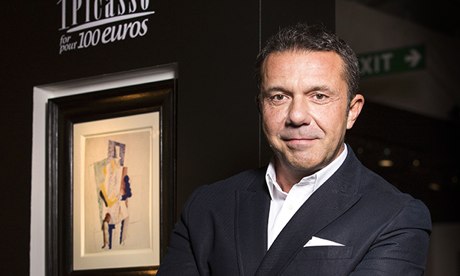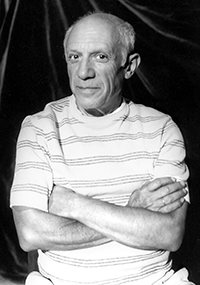A Picasso for £85: why the artist's grandson is raffling a masterpiece
Olivier Widmaier Picasso has spent his life protecting his grandfather's reputation. So what's behind his surprising new venture?


Charity cubism … Olivier Widmaier Picasso with the gouache up for raffle. Photograph: Felix Clay for the Guardian
'I'm a Gemini," says Olivier Widmaier Picasso when we get on to the subject of his love life, "and I really think we're not programmed to be with the same person all our lives." A few years ago, for instance, Olivier, grandson of the great Pablo, was engaged to Alice Evans – the English actor famed for playing Glenn Close's probation officer in 102 Dalmatians a decade or so ago. "I drove her to Pinewood Studios for the final test for that film," he recalls. "And I introduced her to Ioan Gruffuddwhen we got there. So I introduced her to the man who is now her husband."
Not that the 52-year-old Frenchman is rueful. Geminis don't roll that way, apparently. He soon took another lover. "You could say I have moved from my blue period to my pink period," he said at the time. What period is he in now? Olivier – torso of a bull, eyes soulful brown, nose fascinatingly undulating, and altogether a dead ringer for grandad except with more hair – fixes me with those eyes. "I'm not married. But I do OK. You say that? I do OK?"
There's more than a hint of the international playboy about Olivier, who's in London to oversee the British leg of a charity sale of one of his illustrious ancestor's works. Pablo's 1914 cubist gouache drawingL'Homme au Gibus, or Man with Opera Hat, goes on show this week atthe Pavilion for Art and Design (PAD) in Berkeley Square, London, as part of a global tour. The drawing is being raffled to raise money for theInternational Association to Save Tyre, which funds projects for the war-ravaged Phoenician city in Lebanon, a Unesco world heritage site. The gouache was bought from a New York gallery by the IAST and 50,000 tickets, each costing €100 (£85), are to be sold. By the time of the draw in December, the charity hopes to have raised €5m – and have presented one lucky person with a Picasso worth €750,000 to hang in their loo.
For Olivier, this fundraiser is the latest twist in a life lived, prosperously and contentedly, in the shadow of one of the greatest artists of the 20th century. Olivier has written books and made documentaries defending Picasso from suggestions that his womanising was the sign of a closeted homosexual, or that he was a monster who destroyed those around him for the sake of that cliche: his most demanding mistress – art. He's also responsible for brokering the deal that, in 1998, led to Picasso's signature appearing on those Citroën cars. "The other day," he says, "I was getting my car back from the carwash. 'Name?' asked the lady. 'Picasso,' I replied. She looked for the keys. 'We don't have any Citroën Picassos,' she said. 'No,' I replied, 'my car is a Mercedes.'"
His cousin Marina said the deal sullied Picasso's name. What does he think? "We discovered there were something like 700 illegal uses of his name for various products," he says. They needed a partner with the clout to go after them. "Citroën provided that. Our hope was that it was a good car – and it was. Now there is a C4 Picasso, the third generation of the series." Did the deal make him rich? "Yes, but not just me. All of us in the family. Well, we were rich already. Not jetset rich, but rich."
 Pablo Picasso in Antibes, France, 1946. Photograph: Michel Sima/Getty Images
Pablo Picasso in Antibes, France, 1946. Photograph: Michel Sima/Getty Images
Is he like Picasso? "No," says Olivier, who is a lawyer as well as a TV and music producer. "I found out, early and painfully in art class at school, that I have no talent." No similarities at all? "I have inherited that artistic thing of putting people together." A sort of human collagist? "Exactly. That is the talent, if you can call it that, I bring to my work, and my life, too, perhaps." Among his non-Picasso claims to fame is the fact that he producedFrench tennis player Yannick Noah's reggae album.
I was thinking more of parallels between their romantic lives. Woody Allen felt as he does about mating for life – he believed it was only for pigeons and Catholics. Presumably, his grandfather was of the same mindset. "Yes, he would look at a woman and imagine her in paint – and, of course, imagine what she was like in the bedroom." He laughs. "He loved women."
That's not what Arianna Stassinopoulos Huffington argued. In her 1988 book Picasso: Creator and Destroyer, she suggested that the Spaniard's lifelong pursuit of women was a foil – he was really gay. "Nonsense!" says Olivier. "Who could have devoted so much energy to women if they really loved men? He was deeply, sexually and artistically interested in women. That was how he saw my grandmother: muse and lover all in one." This was Marie-Thérèse Walter, the woman depicted in the 1932 painting Le Rêve, or The Dream. She was 22 at the time, he 50. In it, her head is tilted in slumber and her left eye has become an erect penis, presumably symbolising Picasso's own.
Olivier remembers his grandmother late in life, when she was no longer muse or lover, but was still financially supported by the artist. "I have a very clear image of her – a kind of unreal mix of craziness and beauty that must have been captivating once, but was pathological when she was trying to be in 1973 how she was in 1927." In 1977, four years after Picasso's death, Marie-Thérèse hanged herself. "He supported her even after the relationship ended, but after his death the money stopped coming. She loved only him and life was pointless without him."
What was his grandfather like? "I never met him." Does he regret that? "Not really. I was too young to get anything from having met him. I'm not sure a man of 90 would have helped me to understand things." He was 12 when Picasso died – but that day, 8 April 1973, proved a watershed. "Before that, I wasn't sure who my grandfather was. My father didn't want to be known as Picasso's son-in-law and my mother wanted us to have an ordinary life." So Maya, his mother, concealed the cheques that came from her father and that made the childhoods of Olivier and his sister, art historian Diana Widmaier Picasso comfortable – first in Marseille, then in the Paris apartment whose walls were lined with Picassos, a few of which his parents have given to him.
"After his death, it was impossible to conceal the truth. I read the newspapers and watched the television and found answers to questions I had never even imagined." Schoolmates told the teenage Olivier he was not really Picasso's grandson because his mother was born out of wedlock. Not true: in 1972, a new French law allowed married men to recognise such children. "That was great in one way, but terrible in another. It meant there were tribunals to [recognise] Picasso children. The media made it look as if these were lawsuits pressed by children who wanted their share of the inheritance he had denied them. The reality was not this: he was not a cruel, mean man. The opposite." The family's legal entanglements, though, were what led Olivier to study law.
His family life was very much the opposite of Pablo Picasso's. "My parents were faithful to each other for life, as a reaction perhaps to my grandfather. But my mother is an artistic type – impetuous, dreamy. My father [a ship's captain from Marseille] is from the real world. He is rational, she is not. He is 'Why?' and she is 'Why not?' I have inherited both."
In 1986, Olivier added "Picasso" to his name. Why? "To honour him and to express solidarity. I have made my own money in my life, but my life would be unthinkable without his help. I have a duty to him."
A sense of duty prompted him to write, in 2004, a 344-page book calledPicasso: The Real Family Story, based on his mother's remembrances and his own research. He looked through chequebooks, for instance, finding that the artist was more generous in making payments to discarded lovers than the image of him as work-fixated exploiter of women might suggest. Picasso emerges as a larger-than-life, flawed but kind man.
Olivier is not yet done with Picasso. A new book, Intimate Picasso, will be published later this year. He describes it as a coffeetable book with pictures of his grandfather's art and photos of the extended family. "In the past 10 years, I have learned about his art, just as in the previous 10 years I learned about his life. It was time for me to finish the Picasso puzzle – a very complicated cubist puzzle." He has also recently co-written and co-produced two documentaries on the artist. Is your life dominated by Picasso? "90% of my life is my own and 10% duty to Picasso. Us descendants could not live without him."
We wander through PAD's galleries to the front of the marquee, where L'Homme au Gibus has been installed. Why should I buy a raffle ticket? "Because it's beautiful. And it's an example of the synthetic cubist period from the year before he met Jean Cocteau – after which his art moved into the new period, when he designed the costumes and curtain forCocteau, Satie and Diaghilev's ballet Parade and Apollinaire used the term surrealist for the first time." It's a good answer.
A photographer appears. "Shoot that side," says Olivier, offering his right profile as he poses before the drawing. "That's the Picasso side."
Share this on your favourite network
















0 comments:
Post a Comment